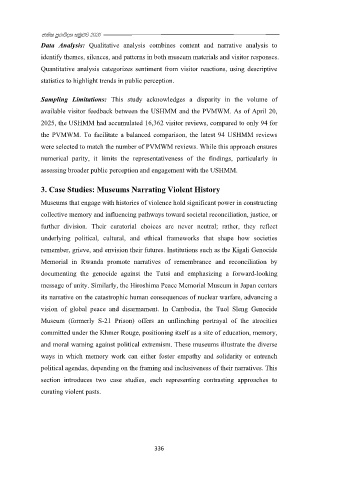Page 357 - Proceedings book
P. 357
q
cd;sl mqrdúoHd iu¿j 2025
Data Analysis: Qualitative analysis combines content and narrative analysis to
identify themes, silences, and patterns in both museum materials and visitor responses.
Quantitative analysis categorizes sentiment from visitor reactions, using descriptive
statistics to highlight trends in public perception.
Sampling Limitations: This study acknowledges a disparity in the volume of
available visitor feedback between the USHMM and the PVMWM. As of April 20,
2025, the USHMM had accumulated 16,362 visitor reviews, compared to only 94 for
the PVMWM. To facilitate a balanced comparison, the latest 94 USHMM reviews
were selected to match the number of PVMWM reviews. While this approach ensures
numerical parity, it limits the representativeness of the findings, particularly in
assessing broader public perception and engagement with the USHMM.
3. Case Studies: Museums Narrating Violent History
Museums that engage with histories of violence hold significant power in constructing
collective memory and influencing pathways toward societal reconciliation, justice, or
further division. Their curatorial choices are never neutral; rather, they reflect
underlying political, cultural, and ethical frameworks that shape how societies
remember, grieve, and envision their futures. Institutions such as the Kigali Genocide
Memorial in Rwanda promote narratives of remembrance and reconciliation by
documenting the genocide against the Tutsi and emphasizing a forward-looking
message of unity. Similarly, the Hiroshima Peace Memorial Museum in Japan centers
its narrative on the catastrophic human consequences of nuclear warfare, advancing a
vision of global peace and disarmament. In Cambodia, the Tuol Sleng Genocide
Museum (formerly S-21 Prison) offers an unflinching portrayal of the atrocities
committed under the Khmer Rouge, positioning itself as a site of education, memory,
and moral warning against political extremism. These museums illustrate the diverse
ways in which memory work can either foster empathy and solidarity or entrench
political agendas, depending on the framing and inclusiveness of their narratives. This
section introduces two case studies, each representing contrasting approaches to
curating violent pasts.
336

